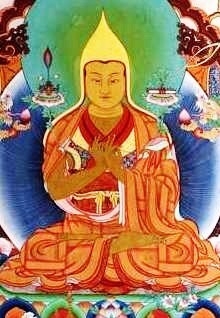Gelug

The Gelug (Wyl. dge lugs) is one of the four main traditions of Tibetan Buddhism. It is the latest of the Sarma schools and was founded by the great Tsongkhapa (1357-1419) in the 15th century. Based on the Kadampa tradition founded by Atisha, it spread quickly through the activity of Tsongkhapa's many illustrious disciples, and eventually became the predominant school in Tibet, with major centres around Lhasa and in Amdo.
Name
Tsongkhapa's followers were first known as the Gandenpas or Riwo Gandenpas, after the monastery of Ganden, which he founded, and only later became known as Gelugpas—'the Virtuous Ones'. They also became known as the New Kadampas.
History
The Gelugpa school was founded by Tsongkhapa Lobzang Drakpa and then propagated by his main disciples, such as Tokden Jampal Gyatso, Gyaltsap Jé, Khedrup Jé, Jamyang Chöjé Tashi Palden, who founded Drepung Monastery in 1416, Jamchen Chöjé Shakya Yeshe, who founded Sera Monastery in 1419, and Gendün Drup, who founded Tashilhunpo Monastery at Shigatsé in 1447 and eventually became known as the First Dalai Lama. Kumbum Jampaling was founded in 1560 at Tsongkhapa's birthplace by Rinchen Tsöndrü Gyaltsen. Jamyang Shyepa Ngawang Tsöndrü founded Labrang Tashikhyil Monastery in Amdo in 1708. Other important Gelugpa masters include later Dalai Lamas, especially the Great Fifth, Ngawang Lobsang Gyatso (1617-1682), and the Thirteenth, Thupten Gyatso (1876-1933), as well as the Panchen Lamas, and the important scholar Changkya Rolpé Dorje (1717-1786) together with his disciple Könchok Jikmé Wangpo (1728-1791)
Teachings
Followers of the Gelugpa tradition rely principally upon the writings of Tsongkhapa, especially his Great Treatise on the Stages of the Path (lamrim chenmo), for their interpretation of the Buddhist teachings. They place great emphasis on philosophical study of the classical Indian treatises, especially on Madhyamika and the view of shunyata. For Vajrayana, the main deity practices are Guhyasamaja, Chakrasamvara and Yamantaka, although Kalachakra is also emphasized.
Further Reading
- Ling Rinpoche, 'The dGe-lugs Tradition of Buddhism in Tibet', Tibet Journal Vol. IV, No. 1, 1979, pages 3-6
- Ringu Tulku, The Ri-me Philosophy of Jamgön Kongtrul the Great (Boston & London: Shambhala Publications, 2006), pages 123-127 & 164-166.
- Tulku Thondup Rinpoche, Buddhist Civilization in Tibet (New York and London: Routeledge & Kegan Paul, 1987), pages 61-66.